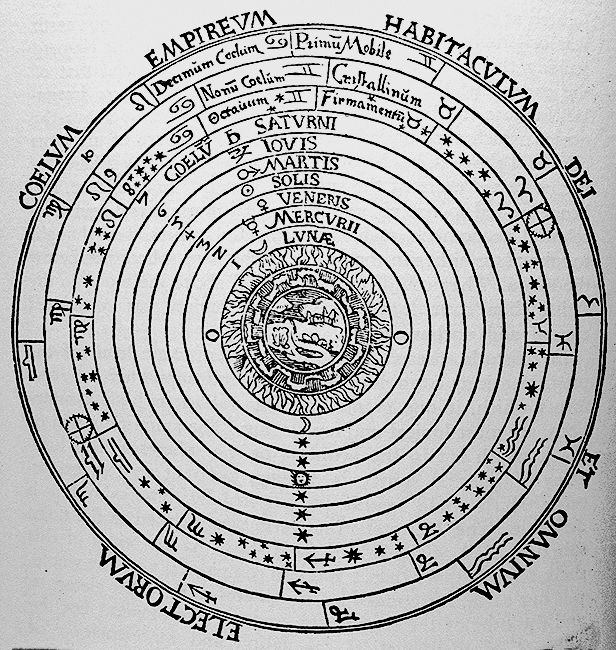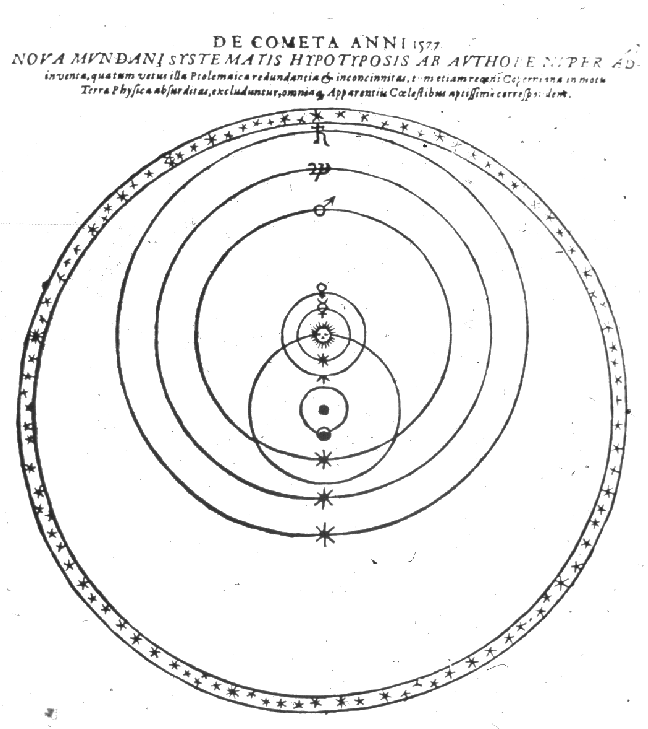 The Anthropocentric
Model of the Universe
The Anthropocentric
Model of the Universe Image source: The Galileo Project (Rice University)
In the first book of the Almagest, Ptolemy presented the cosmological assumptions, which served as the foundation of his astronomy. Ptolemy stated (Book I, chap. 2) that 'the first order of business is to grasp the relationship of the earth taken as a whole to the heavens taken as a whole'. He outlined the 'general preliminary discussion', covering these topics:
1. The heaven is spherical in shape and moves spherically;
2. The Earth is also, when taken as a whole, sensibly spherical in shape;
3. The Earth is in the middle of the heavens, with regard to the senses;
4. The Earth has the ratio of a point relative to the size of the heavens;
5. The Earth has no motion from place to place.
This man-centered or “anthropocentric” model of the universe was based on a series of assumptions. First, it assumed that physical laws were not universal: the region below the moon (a.k.a., the “sublunary” region of the cosmos) was imperfect and subject to change and decay. The heavens, like God, were perfect--eternal, unchanging. Second, the model assumed that every element in the physical world had a natural “place” in the cosmos and was attracted physically to it. Earth was the heaviest element and belonged at the center; was lighter therefore tended to rise to the surface of Earth; fire and air were lighter still, and exhibited a “natural,” upward motion. Thus all motion in the universe was goal-oriented: “natural motion” was the movement of the elements toward their proper place in the hierarchy of celestial spheres. All other motion breached those laws and was therefore “violent”.

 Tycho
Brahe (1546-1601), a Danish astronomer, attempted to reconcile modern
observations of the planetary motions with the Aristotelian/Ptolemaic
universe. Convinced that advances in astronomy depended on accurate observation,
Brahe accepted an offer from the Danish King Frederick II to establish
an observatory on an island near Copenhagen, which he called Uraniburg.
It was far and away the most advanced technologically and accurate observatory
of the time, and the calculations Brahe made with it seriously undermined
key assumptions that underlay the Aristotelian/Ptolemaic model of the
universe. His obervations of a new comet in 1577, for example, established
that these celestial bodies moved through the spheres. Comets could not,
therefore, be carried through the heavens on these solid but translucent,
concentric orbs whose ascending hierarchy of celestial perfection was
thought to comprise the universe. The heavens, Brahe proved, were changeable.
Aristotle's division between the heavenly and sublunary regions was no
longer tenable.
Tycho
Brahe (1546-1601), a Danish astronomer, attempted to reconcile modern
observations of the planetary motions with the Aristotelian/Ptolemaic
universe. Convinced that advances in astronomy depended on accurate observation,
Brahe accepted an offer from the Danish King Frederick II to establish
an observatory on an island near Copenhagen, which he called Uraniburg.
It was far and away the most advanced technologically and accurate observatory
of the time, and the calculations Brahe made with it seriously undermined
key assumptions that underlay the Aristotelian/Ptolemaic model of the
universe. His obervations of a new comet in 1577, for example, established
that these celestial bodies moved through the spheres. Comets could not,
therefore, be carried through the heavens on these solid but translucent,
concentric orbs whose ascending hierarchy of celestial perfection was
thought to comprise the universe. The heavens, Brahe proved, were changeable.
Aristotle's division between the heavenly and sublunary regions was no
longer tenable.